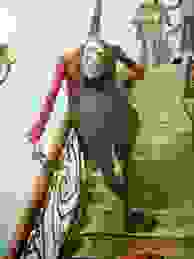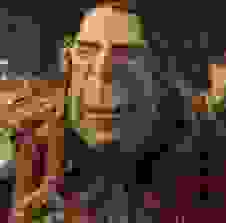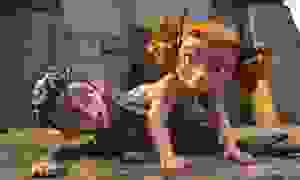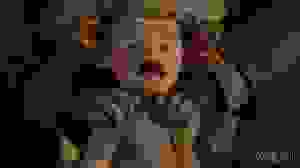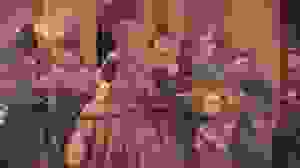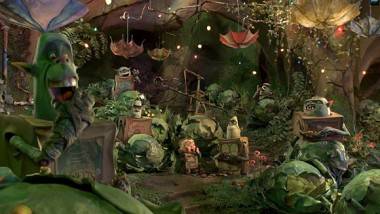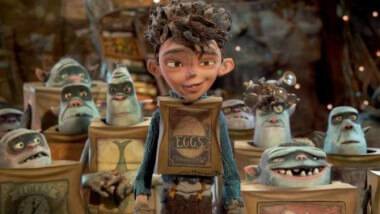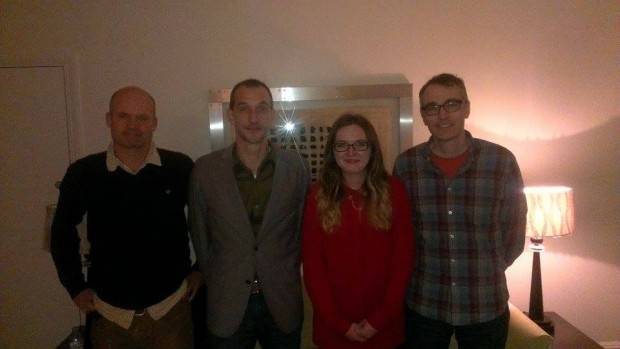Boxtrolls – Interview with Directors Anthony Stacchi and Graham Annable
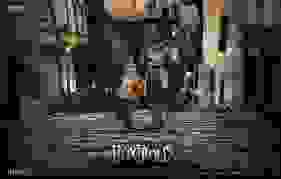
Skwigly writer Steve Cavalier recently met with the very open and super charming Boxtroll directors Graham Annable and Anthony Stacchi (who likes to be called Tony in case you ever meet him) at their suite in the Soho hotel on a recent trip to London. Accompanying Steve was Fiona Stuart-Clark, animation student at Leeds University. A long and in-depth discussion ensued about the directorial duo’s highly impressive recent stop motion feature for Laika Studios and such matters as the working methods of the studio, the use of rapid prototype printer technology for facial replacement animation, the creative involvement of CEO Travis Knight and the career paths of the two directors as individuals.
SC: Great you meet you, I was pleased to do this interview as The Boxtrolls was my favourite animated feature this year, so when the job came up I jumped at it. I thought the film was fantastic technically, in particular, the facial stuff, the camera dynamics, and it had some amazing character animation. And it had the best baddie ever.
AS: Yeah Sir Ben (Kingsley) really brought a lot to that character and they just built an amazing puppet.
SC: It was really nuanced, the animation on that character in particular (Snatcher). Was it just one person who did that?
AS: No. On Coraline they had character leads, but oftentimes what happens is that when a shots ready to come out the pipe, an animator gets assigned it. So a lot of times you’d have three shots in a row and they’d be done by three different animators, so it actually showed up the inconsistencies in the animation style. So with ParaNorman they moved on to a process more of sequence leads, so an animator gets a whole chunk of the film. So that moment when Snatcher meets Winnie in the foggy market square early in the film, Travis (Knight, Laika CEO and lead animator) is always the first on and the first off animator, he took that sequence at the beginning and he started to define the way that Snatcher moved. It happened to be, one of the key sequences, it had written in the script, one part where he says “How did this hat end up aaaaaaaaaaaalll the way out here..”, this elongated word, and thats how it was written in the script. Well Sir Ben took that and with it, every time he said a vowel he would extend it longer, which kind of freaked me out when we first recorded him, like (whispers) “Whats he doing?” , It took me a while, it really took until I flew back to Portland and played it for Graham and Travis, and I thought Travis was going to say “Right, you’re fired get out”, but instead he loved it, it really gave him an image in his head of how to animate the character. Ben said that he based it on somebody that he knew, but he would never tell us who it was. But, really, thats what you want, a recording of dialogue that really excites the animators, they can immediately figure out how to do it. And I think that the way that Snatcher is a kind of wannabe aristocrat and he has this way that he talks that makes him sound more aristocratic, so all of those things kind of built on each other, on top of the great Mike Smith design and then you know, we’ve had three films together with the same crew, building these puppets and they’re getting better and better each time.
SC: That was one of the things I liked about the film, that it just seemed to push everything to quite extreme boundaries, really kind of quirky and really quite surprisingly grotesque, a lot of it, for a mainstream film.
AS: I wish I could say that had all happened because we decided it but a lot of it was really a confluence of a lot of things, the rapid prototype technology, the facial technology, had really advanced over the three films, so the heads could get smaller and smaller and more delicate, and their expressions could be better, and because of that we could make smaller heads, so that the proportions on the characters could get more realistic, so you got that little extra thing, so the grotesquery is in the caricature. And because its a story about this guy who persecuting a minority and he calls them monsters, it was important that everything not be weird, that the monsters looked different and monstery and the people, although caricatured, looked normal. So a lot of that stuff happened, and boy I wish I could have articulated that three years ago, and could say it was my plan, but it just sort of happened! And then Alan Snow’s book, I mean the seed of everything is in there, so that Snatcher character, he’s probably the one who came the most unchanged out of the book, his motivations, his dialogue, that all came from us when we did the story, but Alan’s conception of the villain Snatcher in the book is very much our Snatcher too.
SC: A bit of a joke question really but I was reading that the book (Here Be Monsters! By Alan Snow) is actually based in … is it Trowbridge? And so when Disney go to say, Scotland, or Africa, to research, did you go to Trowbridge?
AS: (Laughs) No we actually went to a French graphic novelist called Nicolas De Crecy who is a really great Bande Dessinee hard cover comic books artist I’d always loved and as soon as I read the book I thought we would get him in to do some inspirational sketches and he came to do a few weeks and that really kind of nailed the look that we ran with.
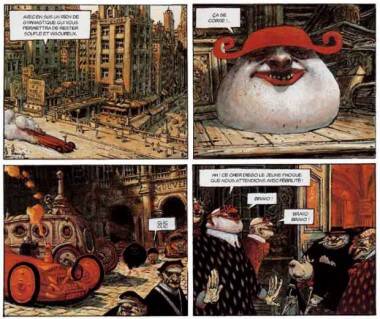
Bibendum Céleste (c) Nicolas De Crecy (More Nicolas De Crecy – http://www.lambiek.net/artists/d/de-crecy_nicolas.htm )
GA: The way that the city of Cheesebridge (in the film) ended up, from the way that Michel Breton, who was our main concept guy , extrapolated from De Crecy’s artwork, ended up with more of a Miyazaki type representation, not London per se, or Britain, but really ended up as pieces of all of Europe, which we should have argued for, a trip round all of it!
AS: It’s an American’s view of Europe, really beautiful old buildings all leaning on each other and sort of falling down and stuff. And then its a super big long book (Here be Monsters!), kind of Dickensian in the way that it creates this whole society and the characters run through this society so you get to know the society at every level, so we had a hard time early on, without long expositional scenes of characters talking about stuff, so we had to explain this visually, so a tall pointed city, really hierarchical, with aristocrats at the top and everyone else at the bottom and middle, so we kept trying to find visual ways of filling in those blanks so we didn’t have to keep talking about them. It worked in that, and it worked in the costume designs, Debra Cook the costume designer, she found a way of making them look Edwardian and Victorian, but also like gangs, the white hats are a gang, snatchers men are a gang, identified by the clothes that they wear, and that helped us visually with the storytelling. She had the most psychotic boards, there was Edwardian, Victorian, but then there was all the clothes the Rolling Stones ever wore and these Japanese musical gangs that hang out in Tokyo and dance at the weekend, she had all this weird reference.
SC: That’s one of the things about it (the film), in a cartoonified way, its extremely British. Like all the voices are British, theres no compromising in that way , like you usually get the main character as an American voice or something like that.
AS: No Travis never baulked at the idea, in fact as we presented it, we didnt think Sir Ben would be interested..
GA: That was one of the ones on our wish list that we didn’t think he actually would take on the role, like an actor of his stature has probably been offered these roles before and hadn’t done it , so we were shocked and very excited that he took it on. But yeah to Travis’s credit he didn’t baulk at all at us choosing the English actors we really wanted that we felt were right.
AS: It was funny too because Richard Ayoade isn’t that well known in the United States but when we went to Comicon and announce the cast that was in that movie there was by far the biggest cheer !
SC: Last week I went to Aardman on a job and I told them I was going to meet you. I was talking to one of the lead animators there and as I’m not really a stop frame guy I was asking him to suggest any questions. He was saying that like me he was absolutely blown away by the technical stuff, like the facial stuff, which is different to Aardmans, where the faces are hand carved where yours is printed out from CG?
AS: Yeah early on on Coraline that was Travis’ idea to drag stop motion into the modern world, its still stop frame, the armatures are still the same as they were in King Kong, much finer made, capable of more movement, but using these rapid prototype printers to generate the faces. The concept of head replace animation has been around a long time..
GA: It’s been around since the forties, George Pal and the puppetoons and all that stuff.
SC: Aardman do facial replacement, like I’ve seen their libraries of hundreds of mouths and stuff, but theirs is all kind of hand carved.
AS: Yeah this way the animators get together with the facial animator , unless they animate on a computer themselves, and then they animate it in Maya on the computer, to the final dialogue, and then they print them out.
SC: It’s amazing because its so smooth it almost looks like CG
AS: It doesn’t have quite the same number of frames, the increments aren’t as close, or their aren’t as many increments, but they’ve got better and better and doing that.
GA: It’s in an interesting space now, where its not quite as herky jerky as everyone associates with stop frame animation, but its not quite as slick as computer animation, so its in an interesting middle ground. I feel it provides something new to an audience, who haven’t seen it at quite that level, but it still seems to be respectful of what the medium is and how it should feel.
AS: We really benefitted from the fact that there are probably only about 30 really fantastic stop fame animators in the world and there wasn’t another stop motion movie being made, so we got all of them.
GA: Because at the time of Coraline and Paranorman there was always another stop motion movie being made, most of it here (UK), and that pool of amazing animators is always a bit split.
AS: Aardman might be really busy, so theres people there and stuff, and we had a few people who had worked at Aardman in the past, so we really lucked out with the cream of the crop. And then Travis keeps a pretty high standard, of wanting it to have weight, and to look realistic and not too cartoony which all lent itself perfectly to our film. In some of the other films the style might change a bit, but thats kind of our (Laika’s) style, that we do pretty naturalistic , on ones, animation.
SC: If I could ask you more about Travis Knight, well my friend at Aardman was saying, with slight jealously in his voice, that because you’ve got this private backer, you haven’t got to deal with all the studios and all the executives, so thats the reason you can produce something like Boxtrolls, something at times quite extreme and not conventionally mainstream.
AS: No it is as close as you can get to independent film making, in an animation setting, and we only have Travis, who is the guy we go through, and he loves animation, he’s not a guy who’s punching his ticket on the way to the top of the studio by working in animation for a while, or someone that has a whole bunch of corporate weight on his back for merchandising and stuff, so we’re freed up a lot in the stories. We don’t have to worry about offending some small group somewhere, we can push the stories to slightly darker places. Its his (Travis) theory not to make dark movies but if we can go to the darker places then then the moments of light and happiness are that much more powerful and stuff, kind of like the early Disney films, which are quite dark, like Pinocchio and Dumbo and stuff.
SC: Yeah exactly those are really the best ones ever aren’t they, because they create higher levels of emotion.
AS: And I think kids like it, you can see kids when they watch the movie, they may not be dancing in their seats as much as Frozen and stuff, but they can see they’re getting a window onto adult issues, that there are themes in here, and jeopardies, that they aren’t used to seeing in animated films. And at least you have their attention, for sure. And we actively wanted to go for a younger audience, theres no supernatural horror element like in Coraline or Paranorman so we skewed it bit younger, we tried to make it a bit more colourful, the scenes that aren’t underground or at night, we tried to make them brighter that the usual stop motion movie, which tend, and I don’t know if its because of stop motion or because of he people who make them, they tend to go in a creepy direction, with Tim Burton sort of looming over the whole art.
FSC: Working together as directors, did you have any dilemmas or struggles of how to split the work up ?
GA: Well I worked as a story artist on Coraline and Paranorman and presumed I’d be a story artist on Boxtrolls. But early on while things were still in development for Boxtrolls and I got a little break on ParaNorman I got the chance to board a sequence for Tony, and that sequence at the time really became the thing that for Travis and for Tony, now we have a piece of this movie. It was abig struggle to figure out Alan Snow’s book and this became this piece that fit what the studio and what Tony wanted to do with it and so it was a kind of melding of sensibilities that I suddenly found myself in helping direct the film. The duo happened because we were really in sync on a lot of things, (to AS) I’m trying to think of specific things you and I got into conflict with?
AS: It would have been story, ’cause like all animation you do the story reel together, and you’d be making that before you make the movie, and theres a lot of back and forwarding with that, and there was a lot of ideas that I thought ‘this has got to be in the movie’ and it ended up not being in the movie.
GA: But in a lot of ways it became you and I as a unit protecting what the film became, and with the rest of the studio trying to convince everybody this was the right way to do things and this was the right film to make, and for that pre production phase we were like joined at the hip, always together figuring out the decisions. And when the shooting schedule begins the studio is really excited to have two directors because they can spilt us to different sequences and have two edit suites going at once and during that theres still voice records to be done, and a lot of them were done here in London, so he (AS) typically would fly over to London for three days but they still had a director in the studio to keep things moving.
AS: Yeah, that 18 months was really hectic, more than I ever ever anticipated.
FSC: Would you say that part of it was the most fun?
AS: The production part? I wouldn’t call it fun!
GA: The funnest part of the whole film, if I’m honest was..
AS: Meeting with you guys!
GA: Haha yeah! When the movie was done and we spent that week here in London with Dario Marianelli doing the final score. Because all the main decisions of the film were done, in place, and here’s this guy with an orchestra who’s elevating everything to this level
AS: And its not a piece of shit, it kind of works, it feels like a real movie!
GA: That was really that moment when you feel the big pieces of it come together and there really is the film in front of you.
AS: Stop motion doesn’t have as much deferred gratification as other forms of animation, like 2D animation gets drawn, cleaned up, inbetweened, inked and painted and composited so you go a long time without seeing what the final films going to look like, and CG the same thing, you get your low res animation and it gets textured and composited and everything. In stop motion what really keeps you going when you’re really exhausted, is that when someone shoots a scene which is just two Boxtrolls on a cobbled street in a dark alleyway, its done. First two weeks of production you see a beautiful scene, you get really excited , its like live action dailys. That never happens in animation. Plus, in most of the CG places Ive worked in, if you squint your eyes and look around, you could be working in a bank. Her every day you go in and theres this sawing and hammering and theres these black curtains surrounding the market square and its all built. And you see it in plywood form and you see it painted and you see the cobblestone streets added and little by little you get the most amazingly beautiful train sets to play with every day, and thats really fun.
GA: That part was really great and as Tony just described you would think that yeah, that must have been the best part of the whole production, but the thing that helps balance how great that is, isthat unlike 2D and CG animation which are much more iterative, and so when your in the role of director you can keep visiting and keep pulling frames and honing and refining and focus on one element, in stop motion its all at once. Its much more akin to theatre I think, you have these incredibly intense conversations with the animators when you go over the animatic to prepare them to go out and make that final shot, and if they’re lucky they’ll get a block, which is something that is shot on like 8’s or 12’s, and just logistically figure out where everything’s gonna be in the shot, then they’ll get a rehearsal which is on like 2’s or 4’s, and you’ll get on clunky glimpse at what the performance is going to be, and then they go to shoot it, and no matter how much prep thats happened in the boards or in all those stages, it kind of feels like the film comes down to that moment and that conversation with the animator before they walk out that door and go to the stage and make the shot that will live for ever more in the film. So we’ve described it it was like 18 months straight of opening night.
AS: With no rehearsals! Its like its taken 100 years for stop frame to figure out the worst attributes of traditional animation and live action film making and mix them up into one cocktail of fear and alienation and stress! And the other defining element of stop frame is that its scare city- you only have so many puppets, so they’re scheduled to the very end of production. So if the rehearsal went wrong and you need him to rehearse again, the producer’s not going to let you do it. That means that puppets out of commission for four days and it throws off the whole schedule. You cant just download another Eggs (the main character in Boxtrolls) like you an download another Woody and have an animator do another shot.
SC: That gives me a real insight into the whole process now because like in CG and live action you do a pre-viz or 3D layouts, theres this other stage after the 2D animatic thats roughing out the animation and stuff, so you have that stage as well?
AS: We did implement CG pre-viz, mostly because we wanted to loosen the camera up. We wanted the cinematography to be less like being trapped on a train set for 90 minutes, as in many stop motion movies, because the camera moves had to be so simple. And the camera moves and cinematography in animation these days, like in How to Train Your Dragon and stuff, is so fantastic these days, so we added that pre-viz. Now that is very crude pre-viz, but we could figure out the cameras.
GA: It didn’t really inform the animation but it was really useful in informing the camera movement and the set builders how much set they needed to really deal with.
SC: Yeah right, so you have that previz, and you have a kind of rehearsal (or two?), that’s a lot of stages isnt it!?
AS: It is.
SC: But I guess you need that as its kind of scary going into the shoot…
AS: Yeah it could be a train wreck in slow motion. The animators do about 30-35 frames a day, 2 or 3 seconds a week, we visit them every day on their sets, we see what they’ve done so far, so were allowed a ten frame cut back, we can say ‘I don’t like the way this is going, cut back ten frames and do this bit over”. Any more than ten frames and the producer comes out, and if that conversation goes on too long the scheduler comes out, you can just hear people starting to show up in the editorial room going “What are these guys doing?”, cos thats a whole day, and that affects the schedule.
SC: It’s interesting, the cutback thing, how do you go back to that frame? Do you match it to a monitor?
AS: Yeah. You can match it to the previous pose that there, they can onion skin it, but if its a subtle movement you’ll never get that pose back.
GA: Yeah it’s misleading in some ways to say we have ten frames we can cut back to. If they’re flying through the air and it’s big poses, you can cut back to that ,sure, but if its a subtle movement you cant really get back there. You have to find a point even further back where a bigger movement has taken place.
SC: Do you ever go “Cut back fifteen frames , but don’t tell anyone”?!
GA: Yeah we’ve tried to do that a few times, but there’s always a production person of some sort in the room!
AS: You can hear whispering going on outside the curtain!
FSC: I’m excited about the DVD coming out, my favourite thing about DVDs is the special features, I was wondering if you could let us know what will be on there?
AS: Well did you see that sequence at the end where Travis is animating Pickles and Trout? More of that. Lots of stuff like sequence breakdowns.. showing the character animation, the rigs removed, the backgrounds added.
SC: That’s interesting, that last shot that you were just referring to, that’s one of the other things I thought; theres no way they would let anyone else get away with that, its almost like an in-joke for animators that you’ve put there for the last minutes of the film! I mean Im guessing everyone else enjoyed it but it seemed like it was particularly aimed at animators!
GA: It almost happened by mistake, the tradition of it, because on Coraline there was this incredibly beautiful animated shot of ghost mice coming floating out of the bricks, and it was something that very rarely happens in a stop motion feature or even an animated feature but at a certain point after that shot was done Henry Selick realised that pacing wise it was slowing down the movie at the wrong time, it wasn’t the right fit for that moment and they had to cut it, and it killed Henry and everybody involved that all this work had gone into this thing and he though you know what, if we can just use it as a behind the scenes look at the rigs and stuff and put it at the end of the movie and just let people appreciate it as its own little piece. It got a great reaction and so on ParaNorman they had a bit where you see ParaNorman from scratch to finish and then he stands up and walks away. So on Boxtrolls we knew we were going to have to figure out our ‘button’ idea and it just so happened that Richard Ayoade and Nick Frost did such incredible stuff in the voice recording, really really funny things where they would just riff on ideas, but part of particularly Richard Ayoade’s humour is that he has these incredibly long pauses in his deliver, which makes things incredibly funny, but we could never fit it into the film in the way he presented it. So we had all this great stuff and we though maybe we can use those guys for the button at the end. And lots of pieces came together in a great way where what they’re saying makes perfect sense for the character’s arc in the film and a perfect thing for Travis to be presented animating and it just all works really well. Like Tony said you get that sense of being immersed in the movie not thinking about the process at all, then you get that nice little bit at the end where it puts it all in perspective of “Wait a minute, thats how this whole film was built”.
AS: I think fundamentally there’s something about stop frame when people look at it that’s in peoples subconscious, their DNA, its in their memory, playing with real objects and imbuing them with a little bit of life, moving them around. So when they see this thing, somehow they know, that’s a real thing, its real fabric and real lights, its not a CG character and stuff. There’s no motion blur, it still looks different, we never want to lose that stop motion charm that’s at the base of it.
You can hear the remainder of this interview in the forthcoming Skwigly Podcast, including discussion of CG set extensions, the fascinating and diverse career paths of the two directors and how they were eyewitness to monumental changes in the industry, the first primitive forms crawling out of the animation pond that became the game changing beasts of Jurassic Park and Toy Story. They also share their thoughts on the the potential future of 2D animation and perhaps confirm or deny the rumours that the person Ben Kingsley based his voice persona for Snatcher was in fact an editor of a certain British online animation magazine. Or perhaps that is something that forever should be shrouded in mystery.
Items mentioned in this article:
![The Boxtrolls [DVD]](https://www.skwigly.co.uk/wp-content/uploads/2015/01/boxtrolls-dvd.jpg)
![The Boxtrolls [Blu-ray]](https://www.skwigly.co.uk/wp-content/uploads/2015/01/boxtrolls-bluray.jpg)


